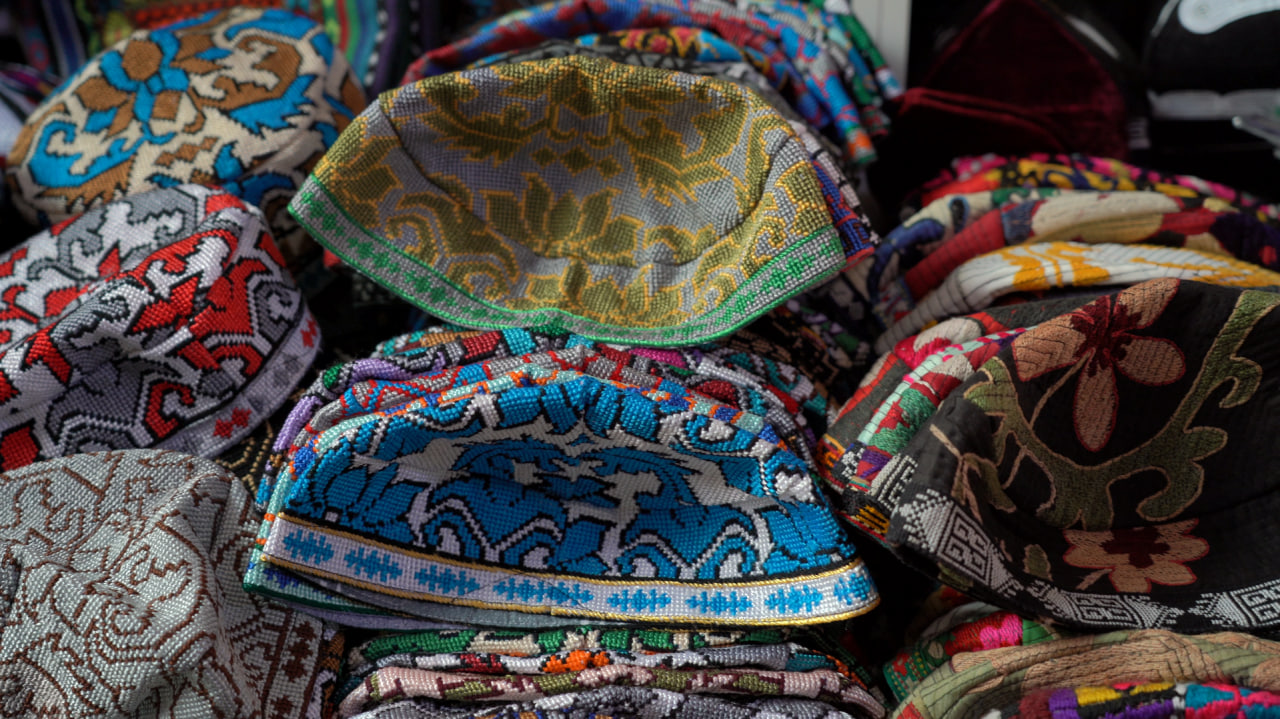Chapan and doppi: Discovering Uzbek national wear for men
Uzbekistan, a land of rich traditions and vibrant history, is renowned for its artisanal textiles and distinctive cultural attire. Among the most iconic garments that reflect the essence of Uzbek heritage are the chapan (a traditional men’s robe) and the doppi (a skullcap worn by men and women alike). These two elements of clothing are more than just functional; they represent centuries of cultural evolution, artistry, and symbolism.
Historical background
The chapan is a long, loose-fitting quilted robe that has been an integral part of Central Asian culture for centuries. Its origins date back to the Silk Road era, when Uzbekistan was a bustling hub of trade and cultural exchange. The design of the chapan reflects influences from Persian, Turkic, and Mongol cultures, yet it has retained a unique identity that is distinctly Uzbek. Historically, chapans were worn by men across all social classes, with variations in fabric, color, and embellishments denoting the wearer’s status and wealth.
Wearing multiple chapans at once was once a mark of prestige, with layers symbolizing affluence and importance. This practice highlights the garment's role as both a practical piece of clothing and a social statement.
Craftsmanship and design
A traditional chapan is a masterpiece of Uzbek craftsmanship. It is typically made using cotton, silk, or velvet, with intricate embroidery or bold patterns decorating its surface. The quilting provides insulation, making it suitable for Uzbekistan’s cold winters. Each chapan consists of three main components:
- Outer fabric: Often adorned with vibrant stripes, floral motifs, or geometric patterns, reflecting regional artistic traditions.
- Inner lining: Crafted from soft cotton or silk.
- Decorative edges: Embellished with braids or embroidery.

This chapan is crafted from Suzani fabric, renowned for its luxurious quality and intricate embroidery. Traditionally, such garments are not intended for everyday use but are reserved for special occasions, such as weddings, or presented as prestigious gifts.
The artistry of the chapan varies by region:
- Bukhara: Renowned for chapans featuring gold and silver embroidery, epitomizing luxury.
- Fergana Valley: Known for vibrant floral designs and high-quality silk fabrics.
- Samarkand: Characterized by bold, colorful patterns symbolizing the city’s dynamic culture.

Said Mir Muhammad Alim Khan, the final ruler of the Bukhara Emirate, (ascended to power in 1910 and reigned until 1920), wearing a chapan.
Cultural significance
In Uzbek culture, the chapan is much more than a garment; it is a symbol of respect, honor, and hospitality. It is often worn during important occasions such as weddings, national holidays, and religious ceremonies. Gifting a chapan is a deeply rooted tradition that signifies goodwill and respect. For example, it is common to present a chapan to honored guests or elders as a token of appreciation.
Colors and patterns carry specific meanings:
- Dark colors (black, navy): Associated with maturity and wisdom, often worn by elders.
- Bright colors (red, green, blue): Symbolize youth, energy, and prosperity.
- Gold embroidery: Denotes high social status and is often reserved for ceremonial chapans.

180-year-old chapan, made of natural silk. Its patterns are made with threads soaked in gold. These kinds of chapans were traditionally worn in the Emirate of Bukhara (1785-1920).
Modern adaptations and pricing
While the chapan remains a staple in rural areas, urban settings have witnessed a resurgence of this traditional attire in contemporary fashion.

This chapan features a simpler design for everyday wear, commonly crafted for practicality and comfort.
Designers are creatively integrating traditional elements into modern designs, appealing to younger generations and international audiences. Some examples include shorter, tailored chapans worn as jackets or coats. Some designer chapans are presented in fashion shows in cities like Paris.
The price of a chapan varies widely depending on its craftsmanship, materials, and age:
- Contemporary chapans: Simple designs cost $20–$30, while more elaborate pieces range from $40 to $200.
- Designer chapans: Unique, handcrafted chapans can cost $200–$500.
- Vintage chapans: Rare, antique pieces dating back up to 200 years are highly sought after by collectors, with prices reaching up to $12,000.
In Tashkent, boutiques offer exclusively designed chapans starting at $350, blending heritage with modern sophistication.
The Doppi
Historical roots
The doppi, or Uzbek skullcap, is another hallmark of the nation’s rich cultural attire. Worn by men, women, and children, this small, round cap is steeped in history. Its origins are linked to ancient Central Asian traditions, with its design evolving over centuries to reflect regional and cultural identities.
Design and craftsmanship
The doppi is handcrafted with meticulous attention to detail. They are typically made from cotton, velvet, or silk, adorned with embroidery, beadwork, or appliqués. Common motifs include floral patterns, geometric shapes, and symbols representing prosperity and protection.
Each region in Uzbekistan boasts distinctive doppi designs:
- Chust (Namangan): Famous for black velvet doppi with white embroidery depicting four almond-shaped motifs, symbolizing life and fertility.
- Bukhara: Known for richly embroidered doppi featuring gold or silver thread.
- Samarkand: Features brightly colored caps with intricate floral and geometric designs.

The doppi is deeply embedded in Uzbek traditions. It is often worn during religious ceremonies, weddings, and festivals. For men, wearing a doppi is a sign of respect and modesty. Women’s doppi, often adorned with beads and sequins, are worn as a decorative accessory.
The cap’s patterns and colors often convey personal or regional identity. For instance, the Chust doppi’s almond motifs are believed to ward off the evil eye, while other designs may symbolize prosperity, unity, or protection.
Modern usage and availability
Today, the doppi is experiencing a revival as a fashionable accessory. It is increasingly popular among younger generations and tourists who appreciate its cultural significance and artistic appeal. Prices for doppi vary based on materials and craftsmanship:
- Simple cotton or silk doppi: $5–$15.
- Velvet doppi with intricate embroidery: $20–$50.
Both the chapan and doppi are powerful symbols of Uzbekistan’s cultural heritage. They embody the nation’s history, artistry, and traditions while adapting to modern trends. Whether worn as everyday attire, ceremonial garments, or contemporary fashion statements, these iconic pieces connect past generations with the present and future.
Related News

13:54 / 25.12.2024
"Wherever freedom is granted, artists are ruining everything" – Ozodbek Nazarbekov

18:03 / 23.12.2024
From Timurid monuments to AI ethics: UNESCO in Uzbekistan

13:06 / 14.12.2024
Legendary Uzbek actor and dubbing master Tulqin Tojiev dies at 88

13:44 / 11.12.2024



